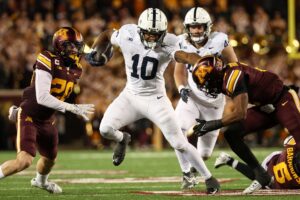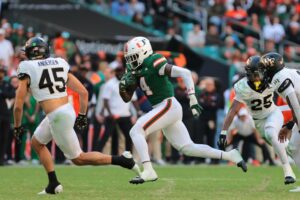Fine-Tuning West Virginia’s Roster
As the Fall camp approaches, Head Coach Neal Brown keeps adjusting his roster. As we wrote last season, WVU planned to save several spots to add transfers based on team needs. They have done just that. We take a close look at the roster movements and status since the end of 2020. While doing so, we analyze how the staff has been fine-tuning West Virginia’s roster.
Attrition after 2020
Before we get to the good news, we thought it useful to address attrition first. Sadly, as it does across the country, the transfer portal also represents a new normal in Morgantown. In most cases, West Virginia’s portal losses reduce depth more than talent. This offseason, however, WVU lost two blue-chip starters in Tykee Smith and Dreshun Miller. Those clearly hurt. The Mountaineers lost two more blue-chip players in David Okoli and Austin Kendall. Otherwise, the team primarily lost largely unproven players who added depth more than proven veteran talent.
As they do every year, West Virginia also lost several to graduation, including Tony Fields and All-American Darius Stills. The only graduating blue-chip player was wide-out T.J. Simmons. Fans will miss plenty of other long-time contributors, but, unlike the transfer portal losses, we see these ones coming. Between the two, WVU lost five blue-chip players from its 2020 roster.
Filling West Virginia’s Roster with Big Pieces
The High School Recruits
While West Virginia’s 2021 recruiting class looked low on numbers (16 recruits), the concentration of higher-tier talent jumps out. In total, Brown signed five blue-chip players, including Wyatt Milum, Kaden Prather, Justin Johnson, Jaylen Anderson, and Andrew Wilson-Lamp.
Still, others fell just outside the cusp of blue-chip status. Players like Will Crowder, Tomas Rimac, Hammond Russell, and Ja’Corey Hammett all fit the bill. As of today, all of the 2021 high school signees have arrived on campus except for one. Only Jaylen Anderson remains elsewhere, though we expect him to join the team in the coming weeks without issue.
The ratio here is important to talk about, by the way. For one, before factoring in the inbound transfers, Brown added more top-tier talent to the roster than he lost. Four left, and five joined the team. Importantly, though, WVU brought in five blue chips players (itself an exceedingly rare feat in Morgantown) out of sixteen. That percentage (31%) represents the highest proportion of blue-chip recruits ever signed in Morgantown, by a fair margin.
The Inbound Transfers
Then, we add the transfers. So far, Brown added five transfers to the team. First, West Virginia native and blue-chip recruit Doug Nester joined the offensive line. Then, four-star linebacker Lance Dixon joined the team from Penn State. Brown also added veteran players Charles Woods (cornerback) and Deshawn Stevens (linebacker). Finally, the staff brought in safety Caleb Coleman, who has several years of eligibility remaining. Each of those players has arrived in Morgantown.
For those keeping count, WVU added seven blue-chip players to its roster out of 21 total inbound players. That ratio (33%) looks even better. That’s also a plus-3 on 4-star student-athletes after the offseason losses. With WVU hitting its recruiting stride, this may be the next tier of that climb Brown’s always talking about.
Position Breakdown
We did a full positional breakdown during our Spring coverage, so we won’t rehash that here. But we want to focus instead on the numbers game.
West Virginia’s Roster on Offense
Offensively, WVU enters 2021 well-balanced. At quarterback, they feature a senior quarterback and two freshmen quarterbacks for a total of three. This is, however, the only offensive position without a blue-chip player in the room. At running back, the Mountaineers feature five backs in the stable, one senior, two sophomores, and two freshmen. Blue-chip talent concentrates here, with three of five being blue-chips.
West Virginia carries eight scholarship wideouts on the roster, with two seniors, three juniors, two sophomores, and one freshman. Two of those eight (Sam Brown and Prather) are blue-chip student-athletes. At tight end, WVU is unusually deep, with five on the roster. Two of them are juniors, one is a sophomore, and two more are freshmen. One of its tight ends (T.J. Banks) was a blue-chip recruit out of high school. Finally, OL coach Matt Moore enjoys twelve offensive linemen in his position room. One is a senior, two are juniors, six are sophomores, and three are freshmen. Four of the twelve are blue chips. That includes Nester, Ja’Quay Hubbard, Chris Mayo, and Milum.
West Virginia’s Roster on Defense
Defensively, WVU finds itself a bit thin in spots. The cornerback room, for example, carries only five scholarship athletes. Fortunately, only one is a senior. Two are juniors, one is a sophomore, and the last is a freshman, They feature one blue-chip in Wilson-Lamp. The Mountaineers hold eight student-athletes in their safety room for three spots. Three of those are seniors, one is a sophomore, and four are freshmen. While the total numbers here are fine, there is an imbalanced distribution. This is the only defensive position without a blue-chip player.
At linebacker, Brown has ten student-athletes in the room. Only three are seniors. Two are sophomores. The remaining five are freshmen. Two student-athletes in this room (Vandarius Cowan and Dixon) carried blue-chip designations out of high school. Finally, on the defensive line, the Mountaineers feature 12 athletes. Two of them are seniors, two more are juniors, three are sophomores, and five are freshmen. In this group, WVU pushes two blue-chip recruits (Dante Stills and Akheem Mesidor).
Fine-Tuning West Virginia’s Roster Overall
In total, West Virginia enters the 2021 season with 70 scholarship players. Considering only 15 of them are seniors, the turnover into 2022 should favor the Mountaineers. Again for those keeping count, West Virginia’s roster features a total of 15 blue chips or 21% of its athletes. This still compares unfavorably to the elite programs. But it also signals the increasing potential for Brown’s blue-collar squad.
That potential could accelerate quickly, too. Outside of unexpected outbound transfers, the Mountaineers graduate just three blue chips after this season. Believe it or not, they should land at least six in its 2022 class. And Brown could land up to 10 (yes, you read that correctly).






